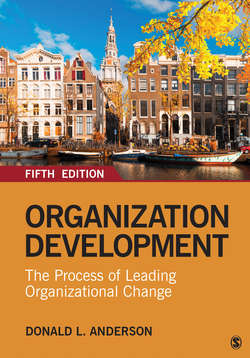Читать книгу Organization Development - Donald L. Anderson - Страница 44
Agility and Collaboration
ОглавлениеToday there is great interest in the field of organization development to improve organizational agility and collaboration. Driven by rapid changes in technology, new competitive environments, and business strategy trends, organizations have sought to improve agility. Consider that Netflix began as a DVD-by-mail service to compete with Blockbuster but subsequently reinvented itself to offer live streaming and eventually produce original content. Upstart competitors can invent a new iPhone app and suddenly compete in significant ways with long-established market leaders. New organizational models such as AirBnB and Uber, the gig economy, and the blurring of industries are all disrupting established enterprises (Anderson, 2019).
Agility “captures an organization’s ability to develop and quickly apply flexible, nimble and dynamic capabilities” (Holbeche, 2015, p. 11). It is also the “capability to make timely, effective, and sustained organization changes” (Worley, Williams, & Lawler, 2014, p. 26). More importantly, agility is an organization design capability “that can sense the need for change from both internal and external sources, carry out those changes routinely, and sustain above-average performance” (Worley & Lawler, 2010, p. 194). These definitions stress three key characteristics of agility (Horney, Pasmore, & O’Shea, 2010):
Fast: Agile organizations operate with speed, making rapid decisions and moving quickly.
Flexible: Agile organizations pivot as needed to take advantage of opportunities as they sense them.
Focused: Being fast and flexible is a recipe for whiplash and chaos unless the organization is also focused. Agile organizations do not pursue every idea, they “do a better job of selecting the ones that will deliver on environmental demands” (Worley, Williams, & Lawler, 2014, pp. 26–27).
Alongside the great interest in organizational agility has been the increasing capability of employees to collaborate with colleagues around the world. High-quality video streaming, instant messaging, and collaboration software allow for more rapid and substantive collaboration than ever before. Researchers have explored alternative organization designs that improve agility and collaboration through means such as alternative structures like holacracies (Robertson, 2015) and global collaborative networks and operating models (Kesler & Kates, 2016).
Moreover, this need for rapid change has changed the nature of organizational change itself. Rather than solely focus on top-down, leadership-driven, planned, and mandated change, OD practitioners increasingly focus on enlisting a wide range of stakeholders throughout the organization to build the organization’s capacity for responsive and adaptive change. This new view of change, called generative change or dialogic organization development (Marshak & Bushe, 2018), will be discussed in Chapters 5 and 12.
As you can see, threads of OD’s history remain with us in contemporary practice. Table 2.1 summarizes the strands of OD reviewed in this chapter and shows how OD’s history influences the field today. Throughout the book, we will see examples of these practices today and learn more about them in detail, and in Chapter 16, we will examine future trends in organization development.
Table 2.1
Summary
Organization development has evolved, adapted, and changed dramatically in the decades since the first T-groups were initiated. Early practitioners and researchers concentrated on individual growth and development through T-groups; action research, survey feedback activities, and sociotechnical systems; and emphases on management practices and employee involvement, whereas later approaches beginning in about the 1980s emphasized larger, systemwide concerns such as culture, change management, and organizational learning. Throughout its history, with new experiences and research programs, academics and practitioners have built on previous practices in order to develop the content and process of OD work to continue to change individuals and organizations. We see elements today of each of these trends in the history of OD. Consequently, OD is not a one-size-fits-all approach to organizational change, nor is it a methodical set of rigid practices and procedures, but it consists of multiple methods, perspectives, approaches, and values that influence how it is practiced. Depending on what a client is trying to achieve, the OD consultant may adapt and adopt a number of practices and approaches, traditional and well tested or cutting-edge and less well known, in order to develop an appropriate intervention strategy that makes sense for the client organization. Many, perhaps most, of these approaches have their roots in the traditions of OD that we have discussed in this chapter. As we cover the process and content of OD throughout this book, you will see how the field retains traces of its history in contemporary practice.
